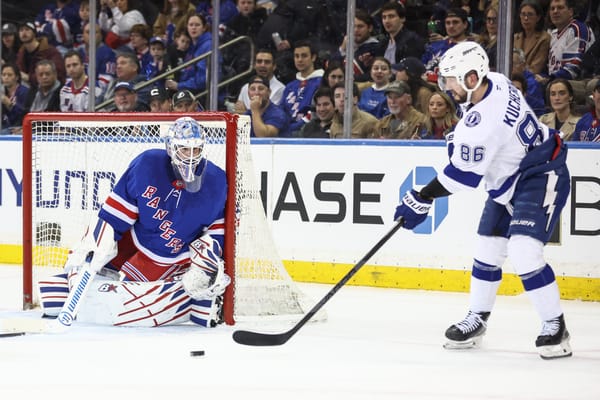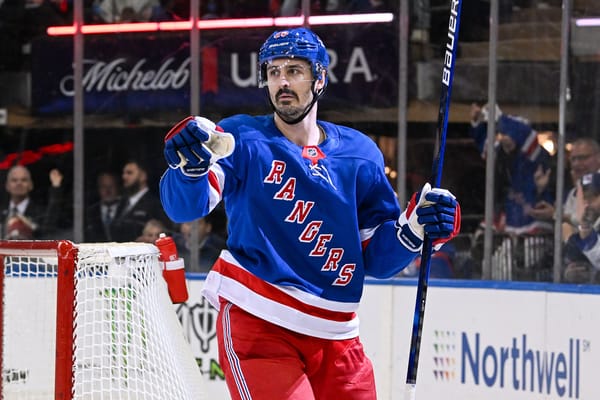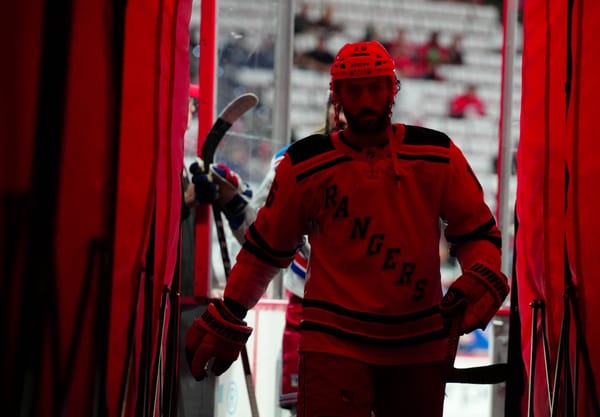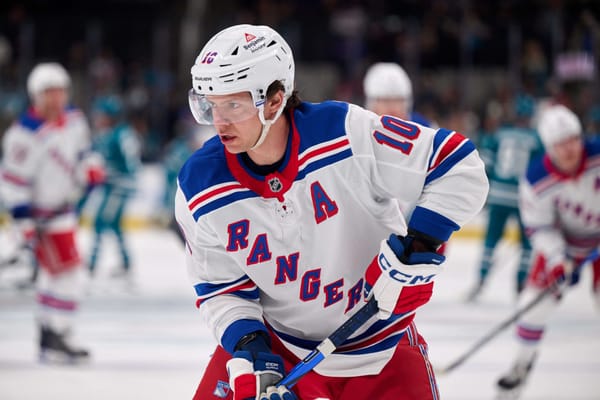Jacob Trouba Would Help Rangers’ Defense, But At What Cost?
Trouba has skills that can help the Rangers, but the cost to acquire appears to be steep.
Defense is arguably the most important area the New York Rangers need to address this summer, but that doesn’t mean getting reckless to do so. Trading the combination of Pavel Buchnevich, the No. 20 overall pick, and prospect Nils Lundkvist to Winnipeg for Jacob Trouba, something floated by Larry Brooks of the New York Post, would be a costly and shortsighted move.
To be specific, this isn’t about losing any of the assets individually; nor is it about the concept of adding Trouba himself. It is about bundling these three quality assets together for a player that is 380 days away from unrestricted free agency if he elects to only sign a one-year deal as a restricted free agent — something that could be likely given his history.
After his entry-level deal ended, Trouba did not agree to a new deal right away, and he eventually signed on the dotted line on November 7, 2016. Once that two-year pact was up, Trouba went to arbitration and asked for $7 million, but ended up with a one-year award worth $5.5 million. After a career year which saw him tally 50 points, his next contract is likely to have a much higher average annual value than he’s had before.
It appears that Trouba’s been looking to maximize his value and have more control over his future with each contract negotiation. Maybe it’s to make his way out of Winnipeg. Maybe it’s to earn the long-term contract he feels he deserves. Players have the right to exercise the limited control they have prior to unrestricted free agency, because the system doesn’t provide a means to always maximize overall value. And at this point, it’s hard to see Trouba being so close to free agency and passing up the golden opportunity to go wherever he wants and get his bag in the process.
While $52.5 million over seven years — the contract Brooks suggested — is a fine sum of money, it’s hard to see Trouba potentially sell himself short. Theoretically a defender like Trouba could ask for $8.5 million, and get at least six years minimum on the open market. If you figure that the cap will rise in line with recent years, and factor in the impact Seattle’s expansion will have on the league, $8.5 million of a hypothetical $85 million cap for the 2020-21 season, and $88 million plus for the 2021-22 season isn’t a ton in terms of percent of the cap.
Also keep in mind how free agents often earn more because teams lure them in with those significant contracts, some of which are enhanced with lucrative bonuses. A lot can change between now and July 1, 2020, but here’s a list of players slated to be available.
Notable UFA Defenders Set to Hit Market on July 1, 2020
Of this list, I’d expect a good deal to re-sign with their current team. But notice that many of these players will be in their 30s by the time they hit free agency, and those who aren’t are just on the edge of 30.
Trouba turns 26 on February 26, 2020, and being one of the younger high profile players to hit free agency adds to his marketability, and provides leverage for his overall asking price. This is why I think regardless of where Trouba plays in 2019-20, he will be doing so on a one-year deal, as opposed to signing for seven years at $7.5 million per.
But if he were to sign that deal, he’d be tied with Aaron Ekblad for the 11th-highest cap hit among defenders, so he wouldn’t be doing too bad for himself. The below list, sans Erik Karlsson’s new deal, provides some context for the top contracts among defensemen.
Therefore, it makes sense that there are a number of team who would like to inquire about Trouba’s availability, trade for him, and subsequently lock him up with a long-term extension. In addition to the Rangers, the New York Islanders and New Jersey Devils reportedly have interest in Trouba, and Brooks speculated that there’s roughly a dozen teams in total interested in Trouba. I’d be shocked if the Detroit Red Wings, and new boss Steve Yzerman, don’t try and land the Rochester, Michigan native who also played NCAA hockey at the University of Michigan.
It goes without saying that the Rangers would and should only consider a trade like this if Trouba is immediately signing an extension — and maybe a trade is already contingent on that. But given the financial implications, does it even make sense at that point for him?
On the surface, paying Trouba isn’t really a problem. The Rangers have the money and he’d help the team on the whole. Some may disagree, but I believe they’re better off betting on Trouba reaching free agency in 2020 if the costs are as high as Brooks suggested, similar to how they operated with Brad Richards and Kevin Shattenkirk, and are with Artemi Panarin.
The Rangers have dealt with Kurt Overhardt — Trouba’s agent — before, as he represents Brandon Dubinsky and Jesper Fast. Overhardt has done a good job getting value for his clients, and notable deals include Ryan Johansen ($8 million AAV for eight years), John Gibson ($6.4 million AAV for eight years) Ryan Kesler ($6.875 AAV million for six years), and Kyle Turris ($6 million AAV for six years).
It is important to note that Johansen signed his extension after his ELC ended, Gibson signed after a three-year bridge, Kesler signed the summer before he was set to become a UFA, and Turris was signed to an extension the day he was traded from Ottawa to Nashville. I only bring this up to highlight that there’s been no set way he’s dealt with his clients, so there really is no telling how things will proceed with Trouba.
If the Rangers were to lose out on Trouba to another team, it wouldn’t be ideal, but they’d still have their assets and cap space to make other moves. The summer of 2020 represents a chance for both Trouba — and by extension of agent fees Overhardt — to cash in, but we will wait and see what happens.
If this trade were to come before or during the draft — which may be the idea so the Jets can add more via the 2019 draft — the Rangers wouldn’t have that chance to speak with Trouba that they would in the interview period between June 26th and July 1. So essentially, they’d be going into a trade somewhat blind as to what Trouba’s intentions are past what the Jets inform them of and whatever is reported — unless Winnipeg keeps the Rangers informed so they can maximize the return.
With that said, let’s look at the trade Brooks suggested from the perspective of who they Rangers would be losing. Pavel Buchnevich is a fine player who can be a part of the solution in New York, but he’s not untouchable. The potential seen in his first three seasons and his top-six projection is something other teams would value.
The No. 20 overall pick certainly is something that makes sense to consider using as an asset, whether it be something used to move up or back in the draft. The value of that pick can/will change depending on how picks before it unfold, so it is fair to consider dealing it ahead of the draft.
Lastly there’s Nils Lundkvist, the Rangers’ No. 28 pick from the 2018 draft who turns 19 in July and looks like he could be a quality top-four NHL defender in due time. Depending on how the team’s forward prospects develop, the Rangers could be looking at 2021-22 or 2022-23 as the first season of being a bonafide Stanley Cup contender.
In these scenarios, Lundkvist is 21/22 respectively, and has the potential to be a key part of the team. In fact, he’d be good insurance if Tony DeAngelo were to fizzle out or Adam Fox doesn’t have the impact the Rangers’ expect him to have. He’d also be able to step into the lineup since there will be openings with the contracts of Shattenkirk, Brendan Smith, and Marc Staal will expiring in 2021.
Overall, his age and potential make him a good fit for the rebuilding Rangers. So while Trouba technically is on the younger side compared to available defenders, the idea isn’t to deplete their pipeline from their top prospects without having similar talent to replenish it.
So if not Trouba, could a trade for a defender with these assets make sense for the Rangers?
The argument could be made for Charlie McAvoy, who is just 21 years old, and is a solid presence on the blue line. He has some experience under his belt, and if acquired would be under team control at a manageable rate for the foreseeable future.
Thomas Chabot, 22, is another young defender who’d fit the bill. In both cases the price would assuredly be more, but adding to it would make more sense in the context of what the team is trying to do. Again, McAvoy and Chabot are mere examples, and even though it is highly unlikely they’d be made available; they are the types of players you bundle multiple assets for. Then again, if all goes to plan the Rangers could have their own version of a young impact defender to add to the lineup in K’Andre Miller, and so on, when their top prospects eventually join the team.
Last year was the first full season of the rebuild, and the Rangers are still early in the process so they have the luxury of time on their side. But at this point you might be saying, the Rangers eventually need to plant a flag in the sand and start building up their roster outside their youngsters — and that’s true.
If you look at their Cap Friendly page, there’s a combination of fringe players, youngsters, and a lot of empty space for the foreseeable future.
As constructed, the roster clearly needs a lot of work, and the direction the team goes in hinges greatly on what happens with Panarin. If he doesn’t end up on Broadway, the Rangers will still have a pretty young forward group lacking an impact point-per-game forward. They then would have to make a decision on Chris Kreider, and whether or not to extend him or use him as bait to acquire someone who could develop into an impact player within the team’s contention window.
The addition of Vitali Kravtsov and Kaapo Kakko/Jack Hughes will help, but realistically each is a few years away of providing the impact the team needs. While Kakko and Hughes have the potential to be elite, only so much can be expected in their first year — just look to the rookie seasons of former second overall picks Andrei Svechnikov (37 points in 82 games), Nolan Patrick (30 points in 73 games), and Patrik Laine (64 points in 73 games).
Plus, there are still lingering questions about their goaltenders — mainly how the transition from Henrik Lundqvist will play out which depends on how Igor Shesterkin will adjust to the NHL — as well as what’s next for the Blueshirts’ bevy of center prospects Filip Chytil, Lias Andersson, and Brett Howden.
Adam looked at this topic more in depth in February, and his roster that included Panarin, Karlsson, and Jacob Trouba didn’t greatly move the needle because of the unknown nature of the rest of the roster. This was pre-Rangers winning the draft lottery, but again, even factoring those players in doesn’t result in a large immediate impact.
Related
Rangers Must Resist Temptation to Expedite the Rebuild
At this point you may be saying to yourself, “Trouba is a high-caliber defenseman who would make the team better; why are you against trading for him? The cost is a younger player who is an RFA, a late first and a prospect years away.”
As I said at the beginning, it isn’t about Trouba the player, but the combination of trading assets, and signing him to an extension when he may not be the best fit for this roster and this point in the rebuild. If the team were further along and a year away from making serious playoff runs, it would be a different story as Trouba would represent something akin to a final piece.
But adding Trouba next season, something Adam worked through in the above, doesn’t move the needle enough to make jumping the gun worth it in the long run. Even it means missing out on him, the team is better off holding onto their trade chips and regrouping.
The Rangers already have defenders on the team of the offensive variety. DeAngelo had an impressive season and showed signs of growth under David Quinn. Adam Fox projects to be a decent offensive defender, and the team still has Kevin Shattenkirk. How the Rangers proceed with him will be interesting, because defensively he wasn’t too bad. His offensive numbers were down because of his lost power play time, but here’s a look at how he compared to Trouba in 2018-19.
And for laughs, here’s a look at the last three seasons.
I bring this up because adding Trouba means the Rangers would more than likely be moving on from Shattenkirk — because they likely see a future in DeAngelo and already have Fox — and the easiest way to do so would likely be via a buyout. The financial implications of the move don’t benefit the team in the long run, and the Rangers need to be sure they know what they are doing if they go down that road. If anything, the Rangers would be smart to play Shattenkirk and give him the chance to increase his value, and then try and move on from him at the 2019-20 trade deadline since he’d only have the rest of the 2019-20 season and one year left on his contract.
Related
Buying Out Kevin Shattenkirk Would Be A Huge Mistake
What the Rangers really need is someone who can anchor a pair and generate some solid defensive results, and I don’t know if Trouba is the best fit based on cost.
Using Evolving-Hockey.com’s WAR and GAR charts show that Trouba has been on a slight decline in WAR, and he took a decline in GAR per 60 after trending up over the prior three seasons. This season Trouba had a career high 50 points in 82 games, which was 17 points more than his prior high of 33 points in 60 games played.
Going a little deeper will show that Trouba’s underlying numbers are somewhat concerning, both individually and relative to his team.
This shows that Trouba has been trending down for in terms of possession, although he’s been on a small uptick compared to others on the Jets. Possessing the puck has been a problem for the Rangers, and that’s an area they need to improve upon. In terms of expected goals, his numbers also dipped this season even though he scored a career high in goals and points.
However, it’s worth noting how his role shifted in recent years — from a more offensive role to being exposed to more defensive situations, and back to an offensive role again this season. Another element to consider is that he has spent time on his offside, the left, which may have influenced his play as well — although, he did play primarily on his right this season because the Jets were without Dustin Byfuglien for much of the season. But to that point, the strain without Byfuglien and his partner Josh Morrissey, who also missed time, also plays a part. Then again, in New York, particularly at first, it’s not as if he’d have the support of players of the skill of Byfuglien and Morrissey.
Here’s a quick look at 2017-18 Trouba vs 2018-19 Trouba for some additional context.
It is unfortunate that there isn’t a larger sample of him in either role, as that would make it easier for the team to project out what he’s capable of.
The fact stands though, the Rangers have to upgrade their defense. Trouba is a serious option to consider because he’d be an upgrade over practically everyone currently holding a spot on the Blueshirts’ blue line.
But this aside, Trouba doesn’t appear to be the best option that they could consider with playing style and potential costs in mind.
Colin Miller is arguably as good as Trouba is and won't cost what Trouba would in terms of assets and contract pic.twitter.com/PKYpfCpDWI
— Kevin (@Kpower90) June 15, 2019
Miller would be a quality option, and the Rangers could get him at a reasonable rate if they were to absorb the final year of David Clarkson’s $5.25 million contract, something that could eventually be put on LTIR if the Rangers needed the cap space. LTIR is somewhat of a convoluted process, and Cap Friendly has all the details on their site. I don’t expect this to happen, and while this a #TheVision deal, it an alternative to consider.
John Davidson talked about patience in his introductory press conference, and the speculated cost of this acquisition is the opposite of being patient.
Cherishing the moment, Davidson — or J.D. — was back at Madison Square Garden today, officially introduced as the new president of the Rangers. Once a star goaltender who helped lead the club to the 1979 Stanley Cup Finals and later an adored TV commentator, he returns with a vow of patience mixed with steely resolve.
“There’s no real secret to it, there’s no magic bullet,” he said. “There’s no blender where you can pull out a real good hockey team. You have to build it, you have to work it.”
At this point next year, the Rangers will have a better sense of their needs at forward, their goaltending situation, Fox, and DeAngelo after another season. So maybe they should be patient until then. And maybe, at this point next season, they could try to sign Trouba, if he’s still available, if they still need the help. He does a lot of things well, and I’d be happy to have him on the team, but I think there are better ways the Rangers can maximize their assets and cap space in the context of the rebuild.
At this point, if the Rangers are trading assets to address an area on their roster right now, it has to be the right assets. And in this deal Buchnevich, Lundkvist, and a first-round pick just aren’t that — particularly not for a rebuilding team.
Trouba is a quality defenseman, and one who’d help the Rangers. But paying the high cost to acquire him via trade would be a move out of Glen Sather’s playbook. The Rangers have been hitting the right notes — for the most part — since announcing their intentions to rebuild — and there’s no reason to change course... yet.
Stats via Corsica and Evolving-Hockey unless otherwise noted.





